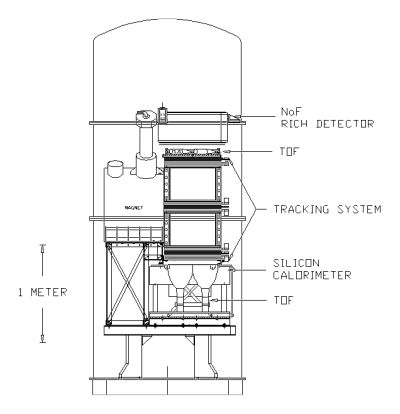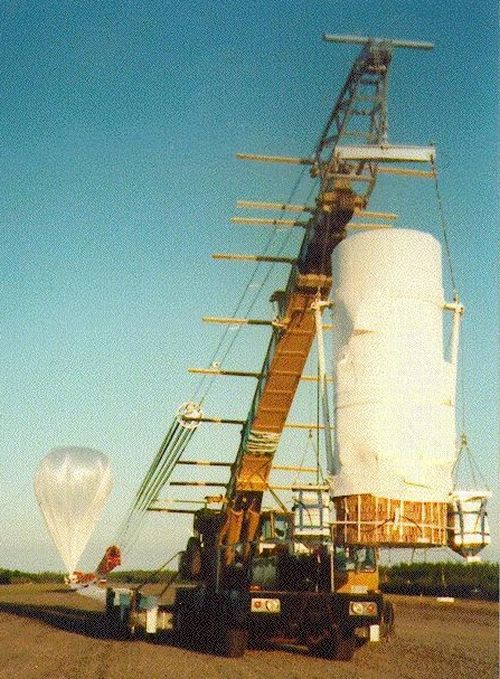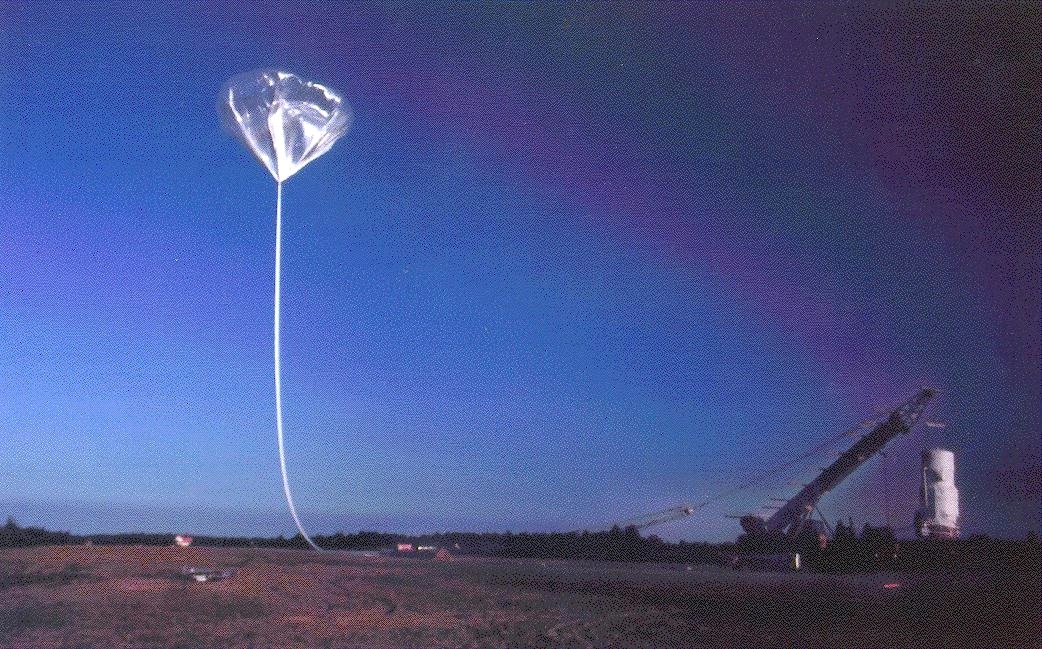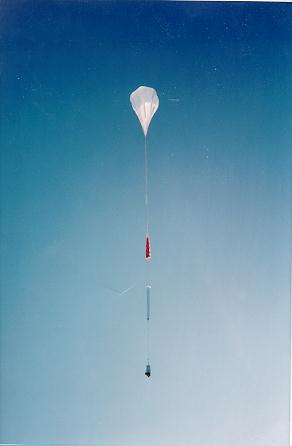Purpose of the flight and payload description
CAPRICE was the acronym of Cosmic AntiParticle Ring Imaging CherEnkov an instrument developed under the Wizard collaboration programme between New Mexico State University (USA), Goddard Space Flight Center (USA), INFN (Italy), University of Siegen (Germany), CRN Strasbourg (France) and KTH Stockholm (Sweden). The group was was formed to bring together the experience of cosmic ray research conducted with balloons of the US groups, with the knowledge of particle detectors of the European groups.
At left we can see an scheme of the instrument (click to enlarge). The apparatus included from top to bottom: a Ring Imaging Cherenkov (RICH) detector, a time-of-flight (TOF) system, a superconducting magnet spectrometer equipped with multiwire proportional chambers (MWPC) and drift chambers (DC) and a silicon-tungsten imaging calorimeter.
The 51.2 x 51.2 cm2 RICH detector used a 1 cm thick solid sodium flouride (NaF) radiator and a photosensitive MWPC with pad readout to detect the Cherenkov light image and hence measure the velocity of the particles.
The time-of-flight system had two layers one above and one below the tracking stack, each layer made of two 1 cm thick 25 x 50 cm2 paddles of plastic scintillator. Each paddle had two 5 cm diameter photomultiplier tubes, one at each end. The distance between the two scintillator layers was 1.1 meters. The TOF system was used to give a trigger, to measure the time-of-flight and the ionization (dE/dX) losses of the particles. The trigger was a fourfold coincidence between two photomultiplier tubes with signals in the top paddle and two in the bottom scintillator paddle. The threshold of each photomultiplier tube was set high enough to eliminate noise, but low enough to provide an efficiency of nearly 100% to trigger minimum ionizing particles.
The spectrometer consisted of a superconducting magnet and a tracking device equipped with multiwire proportional chambers and drift chambers. The magnet consisted of a single coil of 11.161 turns of copper-clad NbTi wire. The outer diameter of the coil was 61 cm and the operating current was 120 A, producing an inhomogeneous field of about 4 Tesla at the center of the coil. The spectrometer provided 19 position measurements (12 DC and 7 MWPC) in the direction of maximum bending (X axis) and 12 measurements (8 DC and 4 MWPC) along the perpendicular direction (Y axis). Using the position information together with the map of the magnetic field, the rigidity of the particle was determined.
The electromagnetic calorimeter consisted of eight 48 x 48 cm2 planes of silicon strip (3.6 mm wide) detectors with both X and Y readouts. These silicon planes were interleaved with layers of tungsten converters, each one radiation length thick. Taking into account all the material, the calorimeter had a total thickness of 7.2 radiation lengths and 0.33 nuclear interaction lengths. The calorimeter provided topological information on both the longitudinal and lateral profiles of the particle's interaction as well as a measure of the total energy deposited in the calorimeter.
All these elements were installed inside a thermally insulated aluminium pressure vessel mounted on a strong baseplate. The structure (a.k.a. the gondola) was 4 meters high, has a diameter of 1.5 meters and weighted approximately 2.100 kgs. It was painted white to reflect sun light helping to balance the heat generated by the electronics in the payload and the irradiation from the Sun and the Earth, with the outside temperature. Power during the flight was supplied by lithium batteries mounted on the outside of the gondola. For a 24 hour long flight with an average power consumption of 1.5 kW it required 180 kg of batteries. When the flight was terminated, the gondola was detached from the balloon and landed with a parachute. To reduce the impact (a 5 g force) upon landing, a crash pad was mounted underneath the gondola. On the sides of the gondola were attached two ballast containers which were operated by telecommand to counteract the lose of altitude of the balloon at night.
Details of the balloon flight
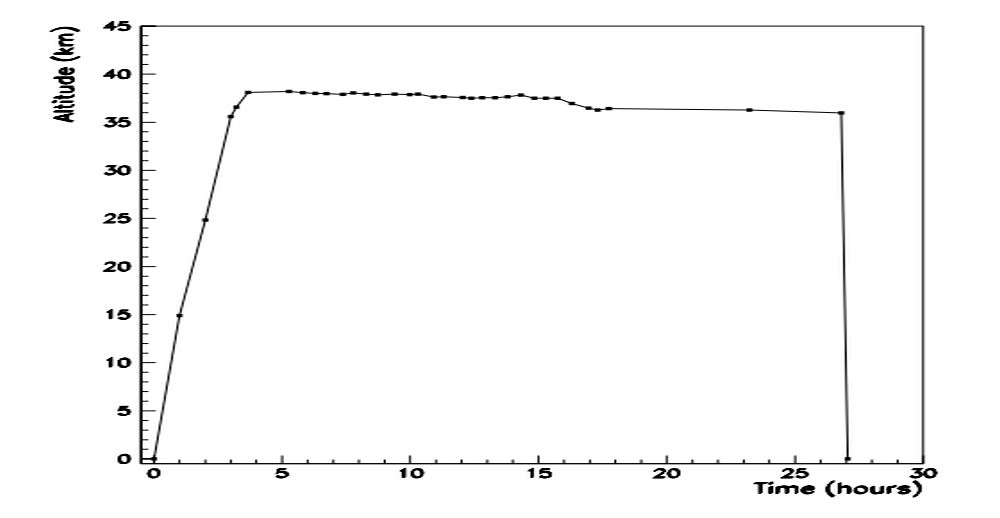
Balloon launched on: 8/8/1994 at 12:26 utc
Launch site: Lynn Lake Airport, Manitoba, Canada
Balloon launched by: National Scientific Balloon Facility (NSBF)
Balloon manufacturer/size/composition: Zero Pressure Balloon Raven 39.570.000 cuft - SF3-459.37-080-NSXCHR-ST
Balloon serial number: W39.57-2-06
Flight identification number: 384N
End of flight (L for landing time, W for last contact, otherwise termination time): 8/9/1994 at 15:03 utc
Balloon flight duration (F: time at float only, otherwise total flight time in d:days / h:hours or m:minutes - ): 23 h
Landing site: 150 km N of Peace River, Alberta, Canada
The CAPRICE experiment was launched from Lynn Lake Airport in Manitoba, Canada at 7.28 local time on the morning of August 8, 1994. After a nominal ascent phase it reached a float altitude about 38.2 km at 11:07. Once at float altitude, the balloon started to move in a westerly direction with a velocity of 10-18 m/s. The position of the payload was monitored during the whole flight by the NSBF using the Global Positional System (GPS). The GPS instrument gave information on the altitude as well as of the latitudinal and longitudinal position. The GPS data was used both to track the payload and to predict possible landing places. In the figure above can be seen the altitude curve as a function of time. The flight altitude dropped during the flight from 38.2 km to 36.3 km.
As long as the payload was in range of the telemetry, commands could be sent directly to the payload and the payload could send data to the ground. When the payload after 18 hours flight got out of range, the control was taken over by a relay station at Ft. Mc Murray, Saskatchewan. At this point, communication from the payload was limited to engineering data but commands could still be sent up to it. Data taking was terminated and all detectors switched off on August 9, 1994 at 8.00 when the payload was running out of battery power. Approximately one hour later the magnet was discharged and at 9.10 the payload was switched off. At this stage the NSBF had full control of the payload and landing preparations started. One hour later, the balloon was detached and the gondola landed by parachute at 11.15, 150 km north of Peace River.
External references
- CAPRICE website Royal Institute of Technology, Sweden (via Archive.Org)
- CAPRICE website University of Siegen, Germany (via Archive.Org)
- A Measurement of the Antiproton and Proton Fluxes in Cosmic Rays using the CAPRICE Experiment Thesis by Niclas Weber PhD TU Stockholm (1997)
- A Measurement of the Proton Spectrum at 1 AU Near Solar Minimum with the Caprice Experiment Proceedings of the 25th International Cosmic Ray Conference 1997, Vol. 3, p.369
- A Measurement of the µ+/µ- Ratio at the Top of the Atmosphere with the CAPRICE Experiment Proceedings of the 25th International Cosmic Ray Conference 1997, Vol. 3, p.317
- Measurement of the flux of atmospheric muons with the CAPRICE94 apparatus Phys. Rev. D 62, 032007 (2000)
- Measurements of primary cosmic-ray hydrogen and helium by the WiZard collaboration Advances in Space Research,Volume 27, Issue 4, 2001, Pag. 755
- NASA Balloon Flights (1989-1998) in NASA Historical Data Book, Vol. VII: NASA Launch Systems, Space Transportation, Human Spaceflight, and Space Science, 1989-1998
- Performance of the CAPRICE RICH detector during the 1994 balloon flight Nuclear Instruments and Methods in Physics Research Section A: Accelerators, Spectrometers, Detectors and Associated Equipment Volume 371, Issues 1-2, 1 March 1996, Pag. 169
- Positrons and electrons in the cosmic radiation measured by the CAPRICE94 experiment Mirko Boezio, PhD thesis, Royal Institute of Technology, Stockhom, Sweden (1998)
- The Antiproton flux near Solar Minimum Measured with the Caprice Experiment 25th International Cosmic Ray Conference, 1997, Vol. 4, p.217
- The CAPRICE RICH Detector 24th International Cosmic Ray Conference, Vol. 3, p.657 (1995)
- The cosmic ray positron to electron ratio in the energy range 0.85 to 14GeV Astronomy and Astrophysics, v.309, p.L15
- The Cosmic-Ray Antiproton Flux between 0.62 and 3.19 GeV Measured Near Solar Minimum Activity ApJ 487 415 (1997)
- The WiZard collaboration cosmic ray muon measurements in the atmosphere Nuclear Physics B - Proceedings Supplements - Volume 85, Issues 1-3, May 2000, Pag. 355
- The WiZard/CAPRICE Silicon-Tungsten Calorimeter 24th International Cosmic Ray Conference, Vol. 3, p. 661
- The WiZard/CAPRICE silicon-tungsten calorimeter Nuclear Instruments and Methods in Physics Research Section A: Accelerators, Spectrometers, Detectors and Associated Equipment, Volume 370, Issues 2-3, 1996, Pag. 403
3736If you consider this website interesting or useful, you can help me to keep it up and running with a small donation to cover the operational costs. Just the equivalent of the price of a cup of coffee helps a lot.

